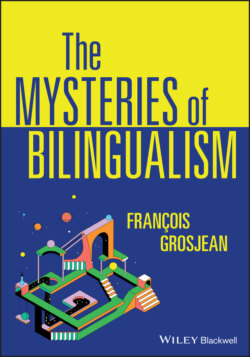Читать книгу The Mysteries of Bilingualism - Francois Grosjean - Страница 16
References
Оглавление1 Anderson, John A. E., Lorinda Mak, Aram Keyvani Chahi, and Ellen Bialystok. 2018. “The language and social background questionnaire: Assessing degree of bilingualism in a diverse population.” Behavioral Research Methods, 50: 250–263.
2 Appel, René, and Peter Muysken. 1987. Language Contact and Bilingualism. London: Edward Arnold.
3 Bloomfield, Leonard. 1933. Language. New York: Holt.
4 Cook, Vivian. 1991. “The poverty-of-the-stimulus argument and multi-competence.” Second Language Research, 7: 103–117.
5 de Bot, Kees. 2019. “Defining and assessing multilingualism.” In The Handbook of the Neuroscience of Multilingualism, edited by John W. Schweiter, 3–18. Hoboken, NJ: John Wiley.
6 de Bruin, Angela. 2019. “Not all bilinguals are the same: A call for more detailed assessments and descriptions of bilingual experiences.” Behavioral Sciences, 9 (3): 33. DOI: 10.3390/bs9030033.
7 De Houwer, Annick. 2019. “Language choice in bilingual interaction.” In The Cambridge Handbook of Bilingualism, edited by De Houwer Annick and Lourdes Ortega, 324–348. Cambridge, UK: Cambridge University Press.
8 Dewaele, Jean-Marc, Alex Housen, and Li Wei. 2003. Bilingualism: Beyond Basic Principles. Clevedon, UK: Multilingual Matters.
9 Grosjean, François. 1982. Life with Two Languages: An Introduction to Bilingualism. Cambridge, MA: Harvard University Press.
10 Grosjean, François. 1985. “The bilingual as a competent but specific speaker-hearer.” Journal of Multilingual and Multicultural Development, 6: 467–477.
11 Grosjean, François. 1989. “Neurolinguists, beware! The bilingual is not two monolinguals in one person.” Brain and Language, 36: 3–15.
12 Grosjean, François. 1997. “The bilingual individual.” Interpreting, 2 (1/2): 163–187.
13 Grosjean, François. 2001. “The bilingual’s language modes.” In One Mind, Two Languages: Bilingual Language Processing, edited by Janet Nicol, 1–22. Oxford: Blackwell.
14 Grosjean, François. 2010. Bilingual: Life and Reality. Cambridge, MA: Harvard University Press.
15 Grosjean, François. 2013. “Bilingualism: A short introduction.” In The Psycholinguistics of Bilingualism, edited by François Grosjean and Ping Li, 5–25. Malden, MA and Oxford: Wiley-Blackwell.
16 Grosjean, François. 2015. “Bicultural bilinguals.” International Journal of Bilingualism, 19 (5): 572–586.
17 Grosjean, François. 2016. “The Complementarity Principle and its impact on processing, acquisition, and dominance.” In Language Dominance in Bilinguals: Issues of Measurement and Operationalization, edited by Carmen Silva-Corvalán and Jeanine Treffers-Daller, 66–84. Cambridge: Cambridge University Press.
18 Hakuta, Kenji. 1992. “Bilingualism.” In International Encyclopedia of Linguistics, edited by William Bright, 175–178. Oxford: Oxford University Press.
19 Haugen, Einar. 1969. The Norwegian Language in America: A Study in Bilingual Behavior. Bloomington, IN: Indiana University Press.
20 Li, Ping, Fan Zhang, Anya Yu, and Xiaowei Zhao. 2020. “Language History Questionnaire (LHQ3): An enhanced tool for assessing multilingual experience.” Bilingualism: Language and Cognition, 23 (5): 938–944. DOI: 10.1017/S1366728918001153.
21 Luk, Gigi, and Ellen Bialystok. 2013. “Bilingualism is not a categorical variable: Interaction between language proficiency and usage.” Journal of Cognitive Psychology, 25 (5): 605–621.
22 Luna, David, Torsten Ringberg, and Laura A. Peracchio. 2008. “One individual, two identities: Frame switching among biculturals.” Journal of Consumer Research, 35 (2): 279–293.
23 Mackey, William. 1962. “The description of bilingualism.” Canadian Journal of Linguistics, 7: 51–85.
24 Marian, Viorica, Henrike K. Blumenfeld, and Margarita Kaushanskaya. 2007. “The language experience and proficiency questionnaire (LEAP-Q): Assessing language profiles in bilinguals and multilinguals.” Journal of Speech, Language, and Hearing Research, 50 (4): 940–967.
25 Rodriguez-Fornells, Antoni, Ulrike M. Kramer, Urbano Lorenzo-Seva, Julia Festman, and Thomas F. Münte. 2012. “Self-assessment of individual differences in language switching.” Frontiers in Psychology, 2: 388. DOI: org/10.3389/fpsyg.2011.00388.
26 Romaine, Suzanne. 2013. “The bilingual and multilingual community.” In The Handbook of Bilingualism and Multilingualism, edited by Tej K. Bhatia and William C. Ritchie, 445–465. Oxford: Blackwell.
27 Sia, Jennifer, and Jean-Marc Dewaele. 2006. “Are you bilingual?” Birkbeck Studies in Applied Linguistics (BISAL), 1: 1–19.
28 Silva-Corvalán, Carmen, and Jeanine Treffers-Daller. 2016. Language Dominance in Bilinguals: Issues of Measurement and Operationalization. Cambridge: Cambridge University Press.
29 Thiery, Christopher. 1978. “True bilingualism and second-language learning.” In Language Interpretation and Communication, edited by David Gerver and H. Wallace Sinaiko, 145–153. New York: Plenum.
30 Wei, Li. 2007. “Dimensions of bilingualism.” In The Bilingualism Reader, edited by Li Wei, 3–22. London and New York: Routledge.
31 Weinreich, Uriel. 1953. Languages in Contact: Findings and Problems. New York: Publications of the Linguistic Circle of New York 1.
32 Zubrzycki, Kamil. 2019. “Am I perfect enough to be a true bilingual? Monolingual bias in the lay perception and self-perception of bi- and multilinguals.” International Review of Applied Linguistics (IRAL), 57 (4): 447–495.
